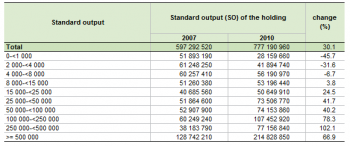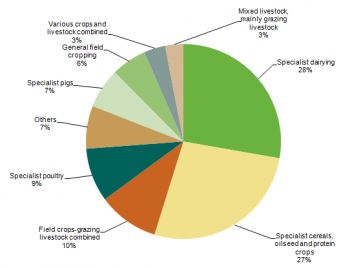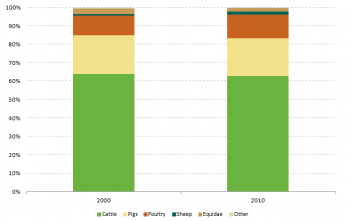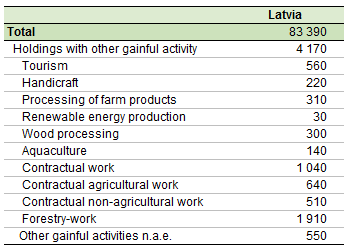Archive:Agricultural census in Lithuania
This article is part of a series of country-specific essays on the results of the European Union (EU) Farm structure survey (FSS) 2010. The FSS collects information on the structural characteristics of the agricultural holdings (land use, livestock and labour force) and is carried out by all European Union Member States every 10 years as an agricultural census, with two or three additional, intermediate sample surveys carried out in-between. The present analysis of the farm structure includes a comparison with the FSS 2003, the first Agricultural census carried out in Lithuania after the re-establishment of the independence. Although the reference years of the Agricultural census in Lithuania were 2003 and 2010 respectively, the common designation is Agricultural census 2000 and 2010.

Source: Eurostat (ef_kvaareg) (ef_ov_kvaa) (demo_pjan) and FSS, 2000 and 2010

Source: Eurostat (ef_kvaareg) (ef_ov_kvaa)

Source: Eurostat (ef_lu_ovcropaa) (ef_oluaareg)

Source: Eurostat (ef_lu_ovcropaa) (ef_oluaareg)

Source: Source: Eurostat (ef_pmhouscatlaa)
Main statistical findings
Key indicators
During the 2000-2010 timeframe, roughly one in four agricultural holdings closed down in Lithuania. Accordingly, as exhibited in Table 1, the number of farms decreased from 272 110 to 199 910.
On the other hand, the Utilised Agricultural Area (UAA) increased by 10 % over the very same period: from 2 490 960 ha in 2000 to 2 742 560 ha in 2010. Accordingly, in 2010 the UAA covered 42 % of the land of the whole country in Lithuania. Similarly, the average area per holding increased between 2000 and 2010 (+50 %), thus suggesting that small farms were incorporated within the bigger ones.
Furthermore, figures on the labour force displayed a similar tendency, as the number of people regularly working on farms dropped by 32 %: from 539 950 in 2000 to 366 090 in 2010. Nonetheless, the number of people employed in the agricultural sector still represented a considerable share of the active population in Lithuania (22.5 %).[1]
According to the FSS 2010 data, in Lithuania there were 0.82 hectares of UAA on average per inhabitant. This value, which represented an increase of 14.5 % if compared to the figure recorded in 2000, was one of the highest in the EU, and also the highest among the Baltic countries.
Agricultural holdings
In 2010, the majority of the agricultural holdings (58 %) were found to have less than 5 hectares of UAA in Lithuania (see Figure 1). The farms whose UAA ranged from 2 ha to 4.9 ha were the most common, accounting for 42 % of all the Lithuanian agricultural holdings. In terms of the agricultural area though, these farms accounted for a minor share: 12 % of the UAA of the country. On the contrary, most of the UAA of Lithuania (54 %) was found to belong to a small number of bigger farms (4 %), i.e. those with 50 hectares or more of UAA.
When comparing the FSS 2000 data with the FSS 2010 data, a general decrease in both the number of holdings and the hectares of UAA could be observed in most of the size classes of farms. In particular, figures fell for all the small and medium sized holdings – the ones whose UAA ranged from less than 2 hectares to 29.9 ha. On the other hand, values for holdings with 30 or more hectares of UAA increased substantially, thus confirming the tendency for the bigger farms to absorb the smaller ones.
The highest increase was recorded for the largest agricultural holdings, those with 100 hectares or more of UAA. Over the 2000-2010 timeframe, their UAA increased by 75 % while their number rose by 84 % in number. Conversely, the sharpest decrease was registered for those farms whose UAA ranged from 2 ha to 4.9 ha: -37 % in terms of both UAA and the number of holdings.
Economic size of the farm
In terms of the Standard Output (SO), the economic size of all Lithuanian agricultural holdings was EUR 1 526 million in 2010. This value, calculated by adding all the standard output per hectare of crop and per head of livestock in a farm, was by far the highest among the Baltic countries.
When compared to the FSS 2007 value of EUR 1 322 million (see Table 2), the FSS 2010 data showed a 15.5 % increase of SO. The growth in terms of SO was recorded for all agricultural holdings, with the exception of those with an economic size of less than EUR 8 000. In particular, the highest increase (73.3 %) was recorded for the farms with an economic size ranging from EUR 100 000 to EUR 249 499. The second highest growth was registered for smaller farms, those with an economic size of EUR 50 000 to EUR 99 999.
On the contrary, the agricultural holdings whose SO was lower than EUR 1 000 showed the sharpest drop (-31.1 %). The second worst drop was recorded for the farms with the SO of EUR 2 000 to EUR 3 999 (-22.7 %).
In 2010, roughly one fourth of all the SO of Lithuania was produced by farms with EUR 500 000 of SO or more. A very similar share was recorded for the farms with less than EUR 8 000 of SO.
Agricultural holding by main type of farming
As exhibited in Figure 2, holdings specialised in general field cropping were found to be the most common in Lithuania. According to the Agricultural census 2010, they represented about 20 % of the total number of holdings. The share of the farms classified as specialised in dairy farming proved to be slightly smaller (18 %), while the farms focusing on various crops and livestock combined accounted for 15 %, as much as the holdings specialised in mixed cropping. Agricultural holdings specialised in any other kind of production recorded a share lower than 10 %.
In terms of the economic size, the hierarchy of the holdings looked different, as showed in Figure 3. When using the SO for measuring the main type of farming, one fourth of the total SO of Lithuania appeared to come from farms specialised in cereals, oilseed and protein crops. A very similar share was reported for holdings specialised in dairy farming. Farms specialised in crop-grazing livestock combined appeared to account for the only other double-digit percentage (13 %).
Land use
The utilised agricultural area (UAA) is the total area taken up by arable land, permanent grassland and meadow, as well as permanent crops and kitchen gardens used by the holdings, regardless of the type of tenure or of whether it is used as a part of common land.
The UAA of Lithuania essentially consists of arable land and permanent grassland and meadows. In 2010, arable land accounted for 77.1 % of the total UAA, while permanent grassland and meadows recorded a share of 22.1 %. Figures looked different in 2000, when arable land accounted for 60.1 % of the total UAA and permanent grassland and meadow shared 39.1 %.
Arable land
In Lithuania, arable land is mainly used for the production of cereals. Accordingly, cereals accounted for 38 % of the total UAA in 2010, a value which highlights an increase of 20.4 % over the 2000 figure. Furthermore, fodder crops gained importance over the years, reaching a share of 20.6 % of the UAA in 2010; in 2000 it was 8.5 %. A similar trend characterised the cultivation of industrial crops, whose share of the UAA changed from 3.3 % in 2000 to 9.8 % in 2010.
Permanent grassland and meadows
Although the area of permanent grassland and meadows is still highly important in Lithuania, it decreased by 38 % over the 2000-2010 timeframe. Consequently, it accounted for 22.1 % of the UAA in 2010 (605 870 hectares). In 2010, almost all permanent grassland and meadow was found to be dedicated to permanent pasture (19.5 % of the UAA), while a small percentage (2.6 %) was recorded as not used for production or eligible for subsidies – generally, this was land used for keeping the soil in good agricultural and environmental condition (GAEC).
Livestock
According to the 2010 data, there were 0.27 Livestock Unit (LSU) per inhabitant in Lithuania. In 2000 there were 0.34, since the number of LSU decreased faster than the population during the timeframe considered.
By far cattle are the most import livestock in Lithuania: in 2010 they represented 64 % of the whole livestock population. According to the FSS 2010 data, the second highest share of livestock was represented by pigs (22 %), with the third being the poultry (10 %). Less important in relative terms, the equidae (3 %) was the livestock that decreased the most over the 2000-2010 timeframe (-56 %).
In 2010, the number of agricultural holdings with livestock halved when compared to the FSS 2000 data: from 253 360 to 129 630. Far from being evenly distributed between all the different size classes of agricultural holdings, this decrease in number of farms with livestock involved more the smaller holdings rather than the bigger ones. According to the FSS 2010 data, the farms with more than 5 LSU and less than 10 LSU were the ones that experienced the greatest fall (-61 %), followed by the holdings with less than 5 LSU (-50 %). On the contrary, the number of agricultural holdings with 20 LSU or more grew. In particular, the number of farms with 50 to 99 LSU tripled, whereas figures for farms with 100 to 499 LSU more than doubled.
Labour force
In the 2000-2010 timeframe, a general fall in the labour force employed in the agricultural sector was observed in Lithuania (see Table 5). According to the FSS 2010 data, roughly one third of the persons working in agriculture in 2000 left this sector.
The decrease appears to be similar both in terms of persons working in agriculture and the Annual Working Unit (AWU), which suggests that mainly persons working fulltime left the agriculture sector over the time under analysis. In terms of sole holders and the gender distinction, figures appear to decline equally for both the gender classes (-32 %); hence the relative share of male and female sole holders did not change over the time considered.
Management practices
Type of tenure
According to the 2010 data, in Lithuania the majority of the UAA (51.3 %) was owned by the farmers who actually worked on that land: 1 406 610 hectares (see Table 6). On the contrary, 1 273 390 hectares of UAA (46.4 %) were cultivated by tenants. The percentage of land under shared farming or other modes was marginal in Lithuania. Accordingly, the agricultural area utilised in partnership by the landlord and the sharecropper, under a written or oral share-farming contract, accounted for 2.3 % of the UAA.
Irrigation
Due to its meteorological conditions, irrigation is of minor importance in Lithuania. Hence, only a marginal percentage of UAA (0.06 %) was irrigated in 2010: 1 530 hectares, for which 1 214 670 cubic metres of water were used.
Animal housing
Among the Baltic countries, Lithuania showed the highest figures in terms of animal housing. According to the FSS 2010 data, there were 93 050 holdings rising 739 090 heads of cattle. The vast majority of housing places were found to be the ones where animals are stanchion tied stable with solid dung and liquid manure (291 240). Furthermore, loose housing with solid dung and liquid manure was recorded as the second most common type of housing (87 530), accounting for 12 % of heads of cattle (see Table 8). The other kind of loose housing, where the animals are allowed to move more freely, accounted for 6 % of the total heads of cattle, while the values related to the housing where cattle are stanchion tied stable with slurry were found to be secondary.
Other gainful activities
In Lithuania, no alternative source of revenue was recorded for the agricultural holdings. Accordingly, only a marginal number of farms (1 510) were found to have other gainful activities in 2010 (see Table 9). Representing a minor share of the whole population of agricultural holdings (0.8 %), these farms recorded activities other than farm work, directly related to the holding and having an economic impact on the holding.
Organic farming
Organic agriculture is an ecological production management system that promotes and enhances biodiversity, biological cycles and soil biological activity. It is based on the minimal use of off-farm inputs and on management practices that restore, maintain or enhance ecological harmony.
Among the Baltic countries, Lithuania had the second widest area under organic farming in 2010, with the highest figure recorded for Latvia. As exhibited in Table 10, the area under organic farming as well as the number of holdings sharing this practice grew steadily over the years. Nonetheless, on a national scale, organic farming remains marginal as in 2010 it was practiced only by roughly 1 % of all the holdings, covering only 4 % of the total UAA.
Data sources and availability
Methodological notes Lithuania – Agricultural census 2010
The Central Statistical Bureau of Latvia (CSB) was the main institution responsible for carrying out the FSS and the SAPM. The Ministry of Agriculture also participated in the acquisition of information. Moreover, on behalf of the Ministry of Agriculture, the Latvian Rural Advisory and Training Centre (LRATC) took part in the Agricultural census.
In Latvia, in compliance with the European Parliament and Council Regulation Regulation 1166/2008, the FSS 2010 was conducted in the form of a Census. Moreover, the first Agricultural census organised in compliance with the requirements of the European Union legislation took place in 2001, followed by the (sample survey) Farm Structure Surveys in 2003, 2005 and 2007.
Survey on agricultural production methods (SAPM)
In 2010 a unique survey was carried out together with the Agricultural census: the Survey on agricultural productions methods (SAPM). This survey collected data at regional level needed to establish agri-environmental indicators as indicated in COM final 508/2006 and to evaluate the greening of the Common agricultural policy.
Data were collected according to specifications listed in Annex V of the above mentioned regulation, namely data on tillage methods, soil conservation, landscape features, animal grazing, animal housing, manure application, manure storage and treatment facilities and irrigation.
In Latvia, the SAPM was conducted as sample survey, the sample size was 20 005 agricultural holdings. It targeted all the economically active agricultural holdings in the Agricultural census 2010 holding list.
In order to ensure the coverage defined by the Regulation 1166/2008 Annex II (98% of the total utilised agricultural area and 98% of the total livestock number), both a physical and economic thresholds was used to select the holdings.
Reference period
The reference period of the Agricultural Census 2010 and the SAPM was the 1st July 2010. Nonetheless, depending on the information to be obtained, it varied so that for:
- the use of utilised agricultural area, it is the crop year 2010,
- the number of livestock, the building and agricultural machinery, it is the 1st July 2010,
- the labour force, it goes from the 1st of July 2009 until the 30th of June 2010,
- the tillage of utilised agricultural and soil conservation, it is the crop year 2010,
- the livestock pasturage period, the animal housing facilities and the manure storage facilities, it goes from the 1st of July 2009 until the 30th of June 2010,
- the average irrigated area, it is the years 2008, 2009, 2010.
Threshold for agricultural holdings
In Latvia, the list of holdings included in the Census was designed using the Statistical Farm Register (SFR), which was developed in the CSB in 1999 and is updated on a regular basis.
In Latvia, the Agricultural census 2010 included only agricultural holdings meeting the minimum requirements of the European Parliament and Council Regulation (EC) No 1166/2008. Accordingly, the smallest agricultural holdings which together represent 2 % or less of the total utilised agricultural area and 2 % or less of the total number of livestock units (LSU) were excluded.
As a result, all the economically active agricultural holdings exceeding 1 ha of agricultural area or EUR 70 of Standard Output (SO) regardless of their agricultural area were included in the Census. Furthermore, the SO threshold was used as a criterion for selecting farms which did not have agricultural area but were breeding livestock.
Common land
In Latvia, Common land existed in 1990s: it was land belonging to local municipalities. Since 2000, all such land has been leased out to several agricultural holdings, therefore in the Agricultural census 2010 it is regarded as land used by the holding. Thus, in the FSS 2010 it is treated as “agricultural area utilised for farming by tenant”.
Geo-reference of the holding
In the past surveys, the location of the agricultural holdings was recorded by registering their address, geographical coordinates of the main production site were not determined. Therefore, in the Agricultural census 2010 the cadastre number of the most significant land parcel had to be indicated in the questionnaire in order to determine the main production site of the agricultural holding, which does not always correspond to the address.
To ensure individual data protection, the geographical coordinates of the agricultural holdings main location were rounded to 5 minutes (5’), by using the 5’ grid.
Economic size
From FSS 2007 onward, the Standard output, a new classification of the economic size of the holding, has been implemented. The SO has replaced the Standard gross margin SGM used before. Nonetheless, for comparability reasons, in FSS 2007 both classifications are available.
Volume of irrigation water
In Latvia, the irrigated areas in open field are rather small (904 ha or 0.05% of utilised agricultural area) and irrigation is irregular.
As reported in the National Methodological Report, variable 8.04 – "Volume of water used for irrigation per year" – includes the volume of water used for irrigation of open field crops and crops under glass (greenhouses). On the contrary, the volume of water used for irrigation of the kitchen gardens is not included.
To find out the volume of water used for irrigation, a methodology was worked out in cooperation with the Latvia University of Agriculture Agency, “Research Institute of Water and Land Management”.
Other methodological issues
Use of administrative data sources
Two administrative sources were used to collect information for the Agricultural census 2010 and the SAPM: the Animal Register and the Integrated Administration and Control System.
The Organic farm register was used for quality control and data comparison at holding level.
A detailed list of all the characteristics concerned is available in the National Methodological Report.
Non-existent and non significant characteristics
Some of the characteristics detailed in the EU regulation 1166/2008 were not included in the Agricultural census 2010, because they were nonexistent or non significant in Latvia. These characteristics are listed in the National Methodological report 2010.
Context
TheEuropean Commission Rural development policy aims to improve competitiveness in agriculture and forestry, improve the environment and the countryside, improve the quality of life in rural areas and encourage the diversification of rural economies.
As agriculture has modernised and the importance of industry and services within the economy has increased, so agriculture has become much less important as a source of jobs. Consequently, increasing emphasis is placed on the role farmers can play in rural development, including forestry, biodiversity, the diversification of the rural economy, in order to create alternative jobs and environmental protection in rural areas.
The FSS continues to adapt in order to provide timely and relevant data to help analyse and follow these developments.
Further Eurostat information
Main tables
- Agriculture, see:
- Structure of agricultural holdings (t_ef)
Database
- Agriculture, see:
- Structure of agricultural holdings (ef)
Dedicated section
Methodology / Metadata
- Structure of agricultural holdings (ESMS metadata file - ef_esms)
- Methodological Report – FSS 2010 Latvia
- Methodological Report – FSS 2007 Latvia
Other information
- Regulation 1166/2008 of 19 November 2008 on farm structure surveys and the survey on agricultural production methods and repealing Council Regulation 571/88
- Regulation 1200/2009 of 30 November 2009 implementing Regulation 1166/2008 on farm structure surveys and the survey on agricultural production methods, as regards livestock unit coefficients and definitions of the characteristics
See also
External links
Notes
- ↑ A value calculated over the total number of active people aged 15 to 64, as it is reported by the 4th quarter of 2010 of the EU Labour force survey (LFS) Population by sex, age, nationality and labour status (1 000) (lfsq_pganws).









